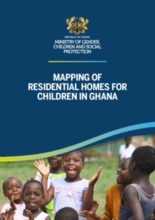Displaced Children and Orphans Fund (DCOF)/USAID are supporting the efforts of the Ministry of Gender, Children and Social Protection (MoGCSP) and UNICEF Ghana to accelerate on-going childcare reform efforts through a 5 year programme, the DCOF/UNICEF/MoGCSP Accelerating Child Care Reform Programme 2015 – 2020. One of the activities is to conduct a comprehensive geographical mapping and analysis of Residential Homes for Children (RHCs) in Ghana to identify the “hot spots” - high concentration of RHCs and/or children in RHCs - and develop a comprehensive understanding of current trends, flows and drivers of children in RHCs in these “hot-spot” (priority) areas.
The geographic mapping identified 115 RHCs in Ghana as at October 2016, caring for 3 586 children. Just over half of all RHCs (53 percent) were located in three Regions: Greater Accra (21 percent); Ashanti (18 percent) and Volta (14 percent), and two-thirds of all children in RHCs in Ghana were in three Regions: Greater Accra (30 percent), Ashanti (22 percent) and Central (12 percent). RHCs are found in 65 (31 Percent) of Ghana’s 216 Districts, with most (82 percent) having one or two RHCs and the remainder (12 Districts) having three or more RHCs with Adenta and Ga West in Greater Accra and Kumasi Metropolitan Assembly (KMA) in Ashanti having the highest number of RHCs, five each in Adenta and Ga West and eight in Kumasi. Twenty-four RHCs in ten districts in the four “hot-spot” regions (Ashanti, Central, Greater Accra and Volta) were selected for in-depth assessments. The mapping exercise was undertaken in the first quarter of 2017. Qualitative and quantitative data was collected from Regional and District Department of Social Welfare (DSW) officials and RHCs. Regional and District DSW staff participated in each of the RHC site visits.

